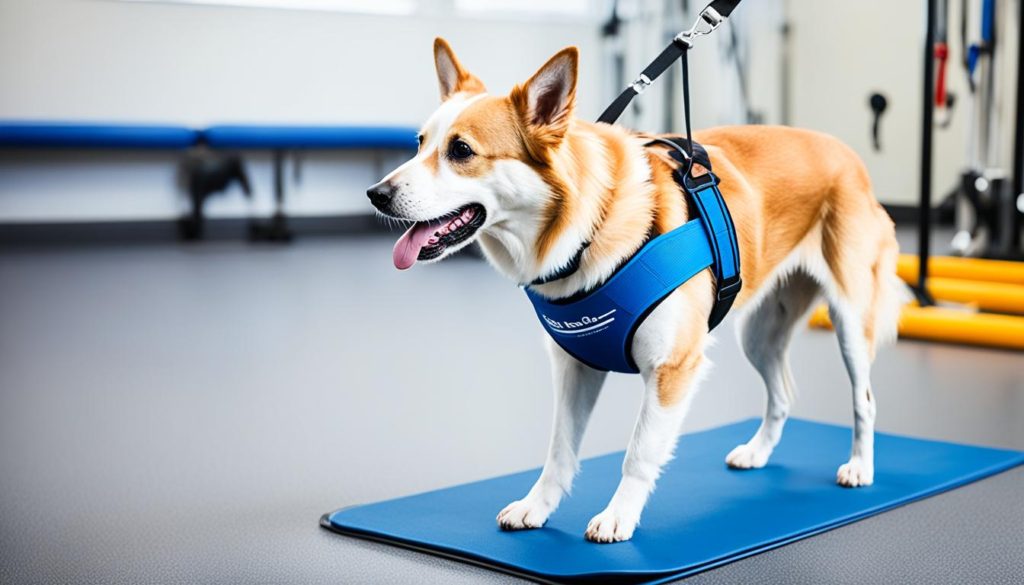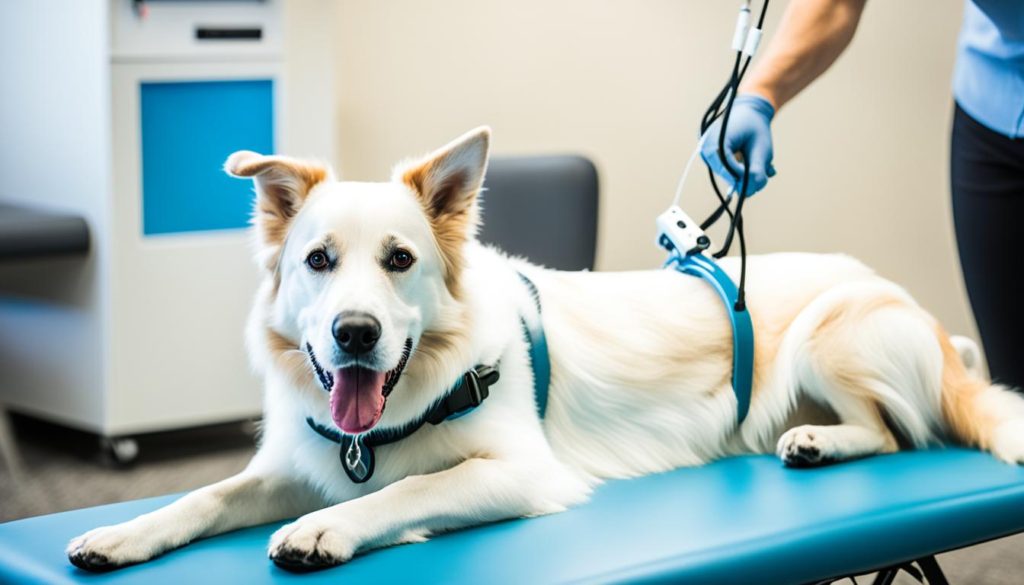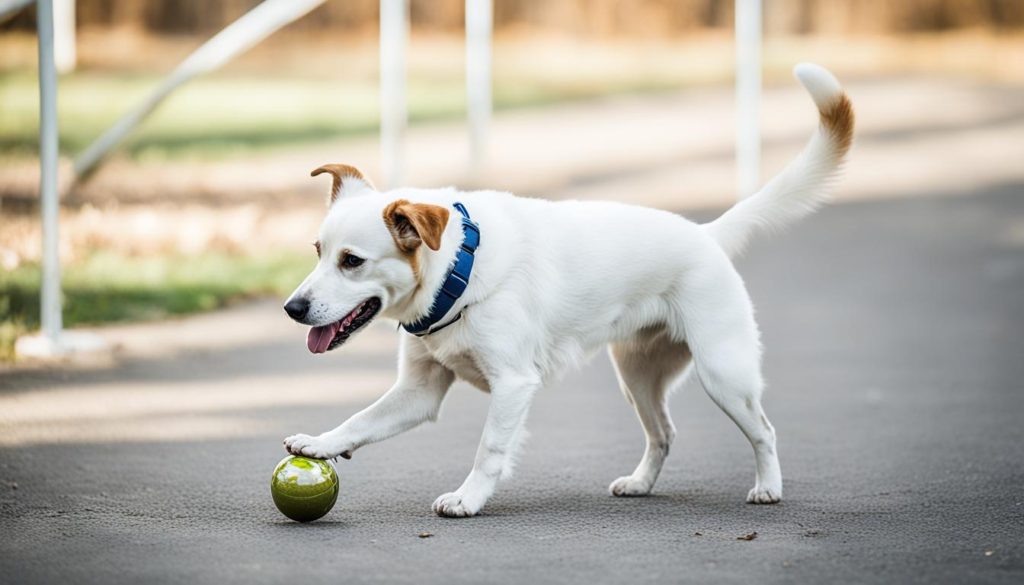If you have a paralyzed dog, it’s essential to understand the signs of recovery to provide the best care and support for their rehabilitation. Paralysis in dogs can result from various spinal cord injuries, and the severity of the injury will determine the symptoms and prognosis for recovery.
Recognizing the key indicators of recovery is crucial for monitoring your dog’s progress and adjusting their treatment plan accordingly. By understanding these signs, you can ensure that your paralyzed dog receives the proper care and support they need to regain mobility and improve their quality of life.
Key Takeaways:
- Paralysis in dogs can result from spinal cord injuries.
- The severity of the injury determines the symptoms and prognosis for recovery.
- Recognizing key indicators of recovery is crucial for appropriate treatment and support.
- Understanding your dog’s progress helps adjust their treatment plan.
- Proper care and support can help paralyzed dogs regain mobility and improve their quality of life.
Understanding Spinal Cord Injuries in Dogs
Spinal cord injuries in dogs can be devastating, causing paralysis and severely impacting their quality of life. These injuries commonly occur as a result of accidents such as automobile collisions or dog bites.
When a spinal cord injury occurs, it can lead to damage of the spinal cord tissues and the disruption of the connection between the brain and the spinal cord. This disruption can result in varying degrees of paralysis, depending on the extent and location of the injury.
Recovering from paralysis in dogs requires understanding the nature of the injury and implementing appropriate treatment. Treatment options for paralyzed dogs may include:
- Surgery: In cases where the spinal cord injury is severe, surgery may be necessary to decompress the spinal cord, stabilize the spine, and promote healing.
- Pain medication: Dogs with spinal cord injuries often experience pain, and medication can help alleviate discomfort.
- Physical therapy: Rehabilitation exercises can help stimulate muscle strength and improve mobility in paralyzed dogs.
- Supportive care: Providing a safe and comfortable environment, including assistive devices like wheelchairs or harnesses, can enhance the dog’s quality of life.
In addition to these treatment options, it’s essential to provide ongoing care and monitoring to ensure the dog’s well-being. Regular veterinary check-ups and adjustments to the treatment plan may be necessary to optimize the dog’s recovery.
Spinal cord injuries can be life-altering for dogs, but with the right treatment and support, many paralyzed dogs can regain some degree of mobility and lead fulfilling lives.
A visual representation of the treatment options for paralyzed dogs is shown in the table below:
| Treatment Options | Description |
|---|---|
| Surgery | Decompresses the spinal cord and stabilizes the spine to promote healing and recovery. |
| Pain Medication | Alleviates pain and discomfort associated with spinal cord injuries. |
| Physical Therapy | Rehabilitation exercises that help improve muscle strength and mobility. |
| Supportive Care | Provides a safe and comfortable environment, including assistive devices, to enhance the dog’s quality of life. |
By understanding the mechanisms of spinal cord injuries in dogs and implementing appropriate treatment options, pet owners can give their paralyzed dogs a chance at recovery and an improved quality of life.
Prognosis for Paralyzed Dogs with “No Deep Pain”
Dogs with “no deep pain,” which refers to the inability to feel their hind paws, usually have a more challenging recovery process. These dogs may experience pain over their spine and have reduced bladder and bowel control. The prognosis for dogs in this category is not as favorable, with a lower chance of recovery compared to other paralyzed dogs. However, with appropriate treatment, including surgery and intensive rehabilitation, some dogs in this category may regain mobility and improve their quality of life.
Paralyzed Dog Recovery Stories
While the prognosis for paralyzed dogs with “no deep pain” may seem daunting, there are countless inspiring stories of dogs who have defied the odds and achieved remarkable recoveries. These recovery stories serve as a beacon of hope for owners navigating the challenging journey of rehabilitation with their paralyzed dogs.
“My dog, Bella, was diagnosed with a severe spinal cord injury and had no deep pain. We were devastated and unsure if she would ever walk again. But with the dedication of our veterinary team and intensive rehabilitation, Bella slowly started regaining movement in her hind legs. It was a long and challenging process, but seeing her take her first steps after months of hard work made every moment worth it. Today, Bella is running and playing just like any other dog, reminding us that miracles do happen.” – Sandra Thompson, Dog Owner
These recovery stories not only provide encouragement but also showcase the incredible resilience and adaptability of dogs. With the right treatment and ongoing support, paralyzed dogs can overcome their limitations and lead fulfilling lives.
Signs of Improvement in Paralyzed Dogs
It’s important for dog owners to closely monitor their paralyzed pets for signs of improvement throughout the recovery process. While each dog’s journey is unique, there are some common indicators that may suggest progress in their rehabilitation. These signs of improvement can include:
- Gradual return of deep pain sensation in the hind limbs
- Increased muscle tone and strength in the affected limbs
- Regaining voluntary movement in the hind legs
- Improved bladder and bowel control
- Decreased pain or discomfort
Remember, every small milestone is a significant achievement in the recovery of a paralyzed dog. Celebrate each step forward and continue to provide the necessary care and support to help your furry companion regain their mobility and quality of life.
| Indicators of Improvement | Description |
|---|---|
| Gradual return of deep pain sensation in the hind limbs | This indicates the restoration of nerve function and can be a positive sign towards further recovery. |
| Increased muscle tone and strength in the affected limbs | Developing muscle tone suggests progress in the dog’s ability to activate and control the affected muscles. |
| Regaining voluntary movement in the hind legs | Voluntary movements, such as attempting to stand or take steps, demonstrate neurological improvement and the possibility of future mobility. |
| Improved bladder and bowel control | Regaining control over urinary and bowel functions is a positive sign of neurological healing. |
| Decreased pain or discomfort | Reduction in pain or discomfort indicates progress in the healing process and improved overall well-being. |
Surgical Options and Recovery for Paralyzed Dogs
Surgical intervention may be recommended for paralyzed dogs, especially those with severe spinal cord injuries. The goal of surgery is to decompress the spinal cord, stabilize the spine, and provide the best chance for recovery. After surgery, dogs will require a period of rest and rehabilitation, which may involve physical therapy exercises, supportive devices, such as slings or wheels, and ongoing medical management to manage pain and prevent complications.
Physical Therapy Exercises for Paralyzed Dogs
Physical therapy exercises play a crucial role in helping a paralyzed dog regain mobility and strength. These exercises are designed to stimulate muscle activity, improve blood circulation, and prevent muscle atrophy. Your veterinarian or a certified canine rehabilitation therapist can provide you with a customized exercise plan tailored to your dog’s specific needs.
- Passive Range of Motion (PROM) exercises: These exercises involve gently moving your dog’s joints through a full range of motion to maintain joint flexibility and prevent stiffness.
- Assisted Standing and Walking exercises: With the help of a sling or a harness, you can assist your paralyzed dog in standing and walking. Gradually increase the duration and distance as your dog’s strength and balance improve.
- Balance and Proprioception exercises: These exercises focus on improving your dog’s balance and body awareness. They may involve having your dog stand on a wobble board or perform weight-shift exercises.
- Aquatic Therapy: Hydrotherapy in a pool or underwater treadmill can provide buoyancy and resistance, making it easier for a paralyzed dog to move and build strength.
In addition to physical therapy exercises, your veterinarian may recommend other forms of rehabilitation, such as massage, laser therapy, or electrical stimulation, to aid in your paralyzed dog’s recovery.
“Physical therapy exercises are essential for a paralyzed dog’s recovery. These exercises help maintain muscle tone and prevent further complications, while also promoting the dog’s overall well-being.”
While physical therapy exercises are beneficial, it’s important to start slow and gradually increase intensity to avoid overexertion or injury. Always consult with your veterinarian or a certified rehabilitation professional before implementing any exercise program for your paralyzed dog.
Supportive Devices for Paralyzed Dogs
In addition to exercises, supportive devices can assist in the recovery and mobility of paralyzed dogs. These devices are designed to provide support, stability, and freedom of movement, helping dogs regain independence and improve their quality of life.
Some common supportive devices for paralyzed dogs include:
- Wheelchairs: A specially-designed wheelchair can support the hindquarters of a paralyzed dog, enabling them to move around and exercise their front limbs.
- Slings and Harnesses: These assistive devices can be used to support your dog’s hind end while walking, providing stability and preventing falls.
- Carts: Carts are wheeled devices that support the dog’s hind end and allow them to move without putting weight on their paralyzed limbs.
These devices should be properly fitted and adjusted to ensure your dog’s comfort and safety. Your veterinarian or a reputable supplier can help you choose the most suitable supportive device for your paralyzed dog.
Remember, recovery from paralysis is a gradual process, and every dog’s journey is unique. With the right surgical intervention, physical therapy exercises, and supportive devices, you can help your paralyzed dog regain mobility and improve their quality of life.

Considerations for Non-Surgical Treatment and Management
In some cases, surgical intervention may not be feasible or recommended for paralyzed dogs. However, there are several non-surgical options available that can help with paralyzed dog rehabilitation and recovery. These alternative approaches focus on managing pain, improving mobility, and enhancing the overall quality of life for paralyzed dogs.
Pain Management
Pain management plays a crucial role in the non-surgical treatment of paralyzed dogs. Your veterinarian may prescribe pain medication or recommend other pain management techniques to alleviate discomfort and improve your dog’s well-being.
Physical Therapy
Physical therapy can significantly contribute to the rehabilitation of paralyzed dogs. It involves exercises and techniques that aim to improve muscle strength, coordination, and range of motion. Under the guidance of a trained professional, physical therapy can help your dog regain mobility and function.
Acupuncture and Hydrotherapy
Acupuncture and hydrotherapy are alternative therapies that can be beneficial for paralyzed dogs. Acupuncture involves the stimulation of specific points on the body to promote healing and pain relief. Hydrotherapy, on the other hand, utilizes controlled movements in water to support and strengthen the muscles. These therapies can be used in conjunction with other treatment options to enhance the recovery process.
Assistive Devices
Assistive devices, such as harnesses or carts, can greatly assist paralyzed dogs in their mobility and daily activities. Harnesses provide support and stability, allowing the dog to move more comfortably. Carts are specially designed to support the hind limbs of paralyzed dogs, enabling them to walk or run with the help of wheels. These devices can greatly improve the quality of life for your paralyzed dog.
Overall, non-surgical treatment and management options offer hope and relief for paralyzed dogs. By combining pain management, physical therapy, alternative therapies, and assistive devices, you can provide your dog with the care and support they need to lead a fulfilling life.

Potential Complications and Long-Term Prognosis
While paralyzed dogs can show remarkable resilience and progress in their recovery journey, there are potential complications and long-term prognoses that need to be considered. Understanding these factors can help guide you in helping your paralyzed dog regain mobility and improve their quality of life.
Complications Associated with Paralyzed Dogs
Paralyzed dogs may be vulnerable to various complications that can affect their overall well-being. Some common complications include:
- Urinary tract infections: Paralyzed dogs may have difficulty emptying their bladder completely, leading to an increased risk of urinary tract infections.
- Pressure sores: Dogs with limited mobility are prone to developing pressure sores, especially in areas where there is constant pressure on their body.
- Muscle atrophy: Lack of physical activity can result in muscle wasting and weakness, further impacting the dog’s ability to regain mobility.
It is crucial to address these complications promptly and provide appropriate treatment to prevent further discomfort and health issues for your paralyzed dog.
Long-Term Prognosis for Paralyzed Dogs
The long-term prognosis for paralyzed dogs can vary based on several factors:
- Severity of the initial injury: Dogs with less severe spinal cord injuries may have a better chance of regaining significant mobility compared to those with more severe paralysis.
- Success of treatment and rehabilitation: The effectiveness of the chosen treatment plan, including surgery, physical therapy, and supportive care, can greatly impact a paralyzed dog’s recovery potential.
- Individual response to therapy: Each dog’s response to treatment and rehabilitation can differ. Some dogs may respond exceptionally well, while others may have slower progress or limited improvement.
It is important to have realistic expectations and work closely with your veterinarian to develop an individualized plan for your paralyzed dog. While some dogs may achieve significant mobility and regain a good quality of life, others may have permanent disabilities and require ongoing support and care.
Inspiring paralyzed dog recovery stories serve as a testament to what is possible. With determination, proper treatment, and a supportive environment, paralyzed dogs can make remarkable progress and enjoy fulfilling lives.
Conclusion
Recognizing signs of recovery in paralyzed dogs is crucial for providing appropriate care and support. Whether through surgical intervention or non-surgical management, the goal is to improve mobility, reduce pain, and enhance the overall quality of life for the paralyzed dog. Each dog’s recovery journey is unique, and it’s important for pet owners to work closely with their veterinarian to develop an individualized treatment plan and ongoing care regimen. With dedication and proper support, many paralyzed dogs can experience improvements and lead fulfilling lives.
FAQ
What are key indicators of recovery in a paralyzed dog?
Key indicators of recovery in a paralyzed dog include regained sensation in the hind limbs, improved bladder and bowel control, reduced pain over the spine, and increased mobility.
What causes paralysis in dogs?
Paralysis in dogs can be caused by spinal cord injuries, such as herniated discs, dislocations, fractures, or compressions. Accidents like automobile collisions or dog bites can result in these injuries.
Can paralyzed dogs recover without surgery?
Yes, surgical intervention may not always be feasible or recommended for paralyzed dogs. Non-surgical options such as pain management, physical therapy, acupuncture, hydrotherapy, and assistive devices can help improve mobility and quality of life.
What is the prognosis for paralyzed dogs with “no deep pain”?
Paralyzed dogs with “no deep pain,” meaning they can’t feel their hind paws, have a more difficult recovery process. The prognosis for these dogs is less favorable compared to other paralyzed dogs, but with appropriate treatment and intensive rehabilitation, some may regain mobility and improve their quality of life.
How can I help my paralyzed dog regain mobility?
Helping a paralyzed dog regain mobility may involve surgical intervention, physical therapy exercises, supportive devices like slings or wheels, and ongoing medical management for pain and complications.
What are the potential complications for paralyzed dogs?
Paralyzed dogs may be at risk for complications such as urinary tract infections, pressure sores, or muscle atrophy. The long-term prognosis varies depending on the severity of the initial injury, the success of treatment and rehabilitation, and the dog’s individual response to therapy.
Can paralyzed dogs lead fulfilling lives?
Yes, with dedication and proper support, many paralyzed dogs can experience improvements and lead fulfilling lives. Each dog’s recovery journey is unique, and working closely with a veterinarian to develop an individualized treatment plan is crucial.
